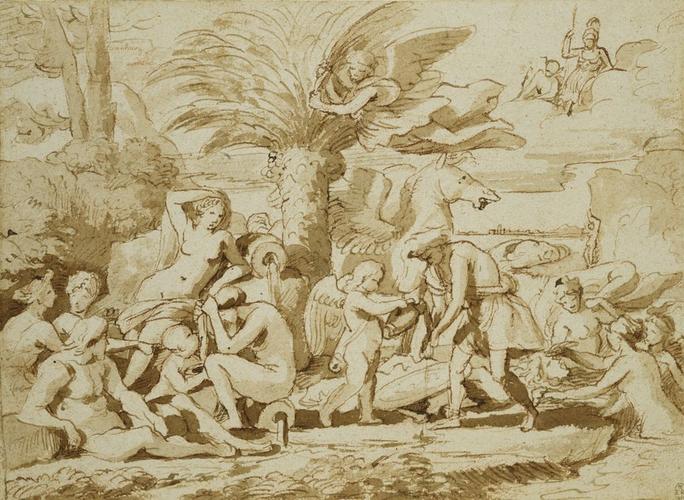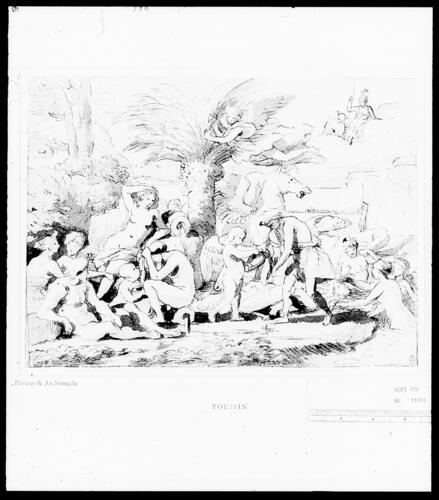Perseus and Andromeda: The Origin of Coral c.1627
Pen and ink with brown wash, over red chalk underdrawing, on pale buff paper | 22.5 x 30.7 cm (sheet of paper) | RCIN 911984
-
A drawing of Perseus washing his hands after slaying the sea-monster, seen dead in the distance before the shackled Andromeda.
The rescue by Perseus of the princess Andromeda, chained to a rock to be devoured by a sea-monster, was one of the most popular tales of classical mythology. But Poussin here presents a rarely depicted episode of the story: while washing his hands after slaying the monster, Perseus laid on the ground the head of Medusa, whose glance turned living things to stone, and whom Perseus had slain earlier. The blood of the gorgon spilled onto the seaweed, which was thus transformed to blood-red coral. Poussin illustrated the mythological origins of natural forms in two other compositions, the Realm of Flora (RCIN 911983) and Venus and Adonis Hunting: The colouring of the rose (a copy, RCIN 911877). Coral held a peculiar fascination for the seventeenth century, and many precious objets d'art incorporating coral, such as figures of the transformed Daphne or Actaeon, alluded to its reputed metamorphic nature.The principal source for the story was Ovid's Metamorphoses (IV, 740ff; the legend can also be found several times in the poetry of Poussin's associate Giovanni Battista Marino). It is evident from certain features of the drawing that Poussin was using the widely read Italian translation of the Metamorphoses by Giovanni Andrea dell'Anguillara, who altered many of the details of Ovid's stories and added much picturesque incident. He (and not Ovid) described how, having slain the monster, Perseus flew to an island where he tied his steed, the winged horse Pegasus, to a palm. Only after washing his hands, in Anguillara's version, did he return to free Andromeda, who can be seen still chained to the rock in the distance here, with the monster dead before her. Sea-nymphs play with the newly transformed coral, but the role of the figures to the left of the composition - including a river-god and two or more naiads - is not clear. Perseus's protectors Mercury and Pallas, visible in the clouds, are mentioned in an earlier verse of Anguillara's translation, but no textual source refers to a cupid pouring the water for Perseus. Poussin based that figure on a putto untying Andromeda in the illustrated French edition of Philostratus, Les Images ou Tableaux de plate peinture des deux Philostrates (Paris 1614).
A large finished version of the Origin of coral, not in Poussin's hand, is also at Windsor (RCIN 911879). There is no associated painting by Poussin, but the composition was known outside Poussin's immediate circle: although differing in many details, a painting in Munich by Sébastien Bourdon of this rare subject has an obvious link with Poussin's design. The compositional principles are very similar, and the distinctive palm and flying Victory are direct quotations. It is unclear how Bourdon could have known the composition, for although he was in Rome between 1634 and 1637 he seems not to have fraternised with Poussin, nor with Cassiano dal Pozzo, from whose collection the finished versions ultimately came to Windsor.
The association of a second painting with the composition is rather easier to explain. A coastal landscape of the Origin of coral painted by Claude in 1674 (Holkham Hall) shows Perseus washing his hands in a stream of water poured by a cupid - an exact reversal of the group in Poussin's composition - with Pegasus tied to a rather prominent palm behind and nymphs playing with the coral to the left. The present drawing was almost certainly known to Claude, for it was then in the collection of Cardinal Camillo Massimi, who commissioned the painting from Poussin's compatriot and old friend nine years after Poussin's death.
Three copies of the drawing are known: in Düsseldorf, attributed to Giuseppe Passeri (Rosenberg & Prat 1994, R353); in the Crocker Art Gallery, Sacramento (R1099); and in the Louvre (R711).Provenance
Cardinal Camillo Massimi (1620-1677); from whose heirs bought in 1739, for 300 scudi, by Richard Mead (1673-1754); probably presented to Frederick, Prince of Wales, by 1750.
-
Creator(s)
Acquirer(s)
-
Medium and techniques
Pen and ink with brown wash, over red chalk underdrawing, on pale buff paper
Measurements
22.5 x 30.7 cm (sheet of paper)
Object type(s)
Other number(s)
RL 11984Alternative title(s)
Perseo ed Andromeda











